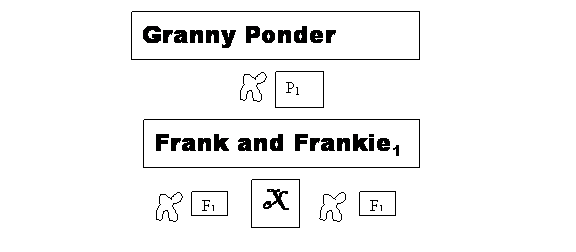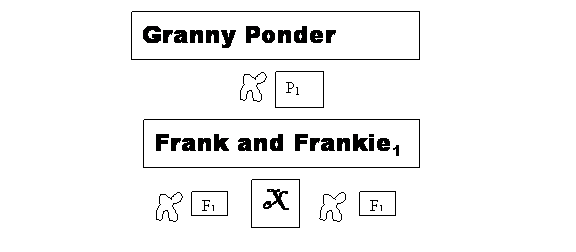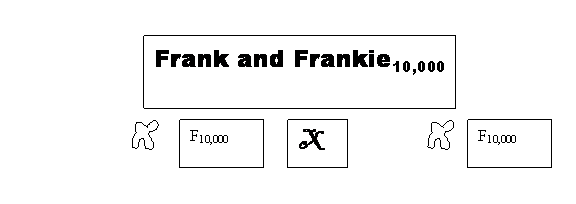
Speciation and population size:
Let us invent a woman. We shall call her Old Granny Ponder.
She has chromosomes. We will consider just one, which we shall call P1.

Our dear ancestress now has two children Frank1 and Frankie1. Each has a copy of the original cromosome P1. We will call those copies F1. F1 is not exactly like P1, and one F1 is not exactly like the other F1. Things change. If you have forgotten that, please review the rant entitled “Evolution demands speciation.”
And now sadly suppose Frank1 and Frankie1 consider marrying to have children. That would be incest. It would be a Bad Thing. If they had children, those children will probably have fertility problems.
So we will put a big nasty X between them to show they should on no account marry.

Now we will say all of Frank1’s childern are either Frank2 or Frankie2 and all Frankie’s children are Frank2 or Frankie2 and so forth generation after generation. After a few generations, we get to Frank5 and Frankie 5. They are 4th cousins, and it would be fine for them to marry. We indicate that with a check mark.

Time passes.

(Sorry, we are having formatting problems. That empty square on the left should coutain a "5" and the one on the right shouldn't be there.) All right. You see what I am doing. Now Frank6 goes off on a long trip. While he is away, glaciers melt, the sea level rises, a land bridge washes away, he gets a hole in his shoe. He never gets home. No matter. He marries a local woman and does well. Now a lot of time passes. More than 9,990 generations go by. That may be longer than there have been modern humans and at least longer than it has been since our ancestors all lived in a tight little community. But go with me on this. Finally his son, Frank10,000 gets the itch to wander, builds a boat and somehow gets back, where he meets Frankie10,000.
But they cannot marry and have fertile children. Speciation has occurred. Speciation is inevitable. If you doubt that, go back and look at “Evolution demands speciaiton. So the two must not marry, any more than if they were brother and sister. We indicate that with another X.



So look at it from the chomosome’s stantpoint. Chromosome F1 cannot function well with another chromosome F1 because they are too similar. Chromosome F5 can function quite well with another chomosome F5 because they are just right. But chomosome F10,000 cannot function well with another chromosome F10,000 because they are too different.
Now suppose Frank6 instead of going on a long perious journey had simply moved to a smallish town of a few thousand people. And suppose the town is always the same size. Nobody enters or leaves. Everyone has an average of 2 children. Frank6 is lucky enough so that there is a Frank10,000. On average none of Frank6’s desccndants will meet and marry until the generation of Frank 10,000. But chromosome 10,000 has no idea whether any glaciers ever melted. All it can do is try to function with whatever chromosome it is mated with, and if that chromosome is a Frankie10,000 chromosome or more distant, there will be infertility.
So a town of 10,000 cannot survive unless there are lines that are constantly dying out, leaving behind people who are sufficiently related.
This is not a difficult thing to understand. It was obvious from the moment somebody realized that the chromosomes he or she was looking at under the microscope were the same as the genes that Mendel had described. That has been something like 100 years.
That’s all you need to know. This whole project has been fluff. All the current data I have piled up, the computer progam the whole works proves nothing that could not have been proven generations ago.
How could people have ever been so dense?
All right, 10,000 generations is a rediculously long time. But there is a little story you need to know. A man asked a starlet if she would marry a man she did not love for a million dollars. (Nowadays you should think ten million.) She anwsered that, yes, she would probably do that. Then he asked her if she would sleep with him that night for forty dollars.
She said, “What do you think I am?”
He said, “That has already been established. Now we are just haggling over the price.”
So we know 10,000 is too many. Well, given some lines dying out, maybe one could squeak by. But 100,000? A million? Survival would not be possible unless the population dropped to a handful, and probably not even then. We are haggling over the numbers.
The principle has been established. Don’t go there. Don’t do that. Don’t let anybody else go that route without full knowledge of what they are doing to themselves and their children.
There have been 2,378 visitors so far.